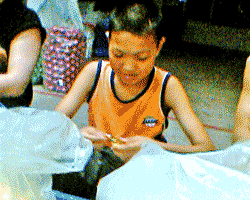
Six months ago, they were just kids hoping to make some extra dough at a summer job. Now this group of fearless Chinese high school students finds itself up against the largest retailer in the world—Wal-Mart. With the help of the National Labor Committee—the American outfit famed for shaming Kathy Lee Gifford for her line’s exploitative labor practices—the teenagers have brought to light yet another scandal with big implications. Turns out the Guangzhou Huanya ornaments factory in Guangdong, where the high school students worked, employs children as young as 12, who are forced to work 15 hour days, 7 days a week to make Wal-Mart’s Christmas ornaments in time for the holiday season. It might come as no surprise that the wages paid by the big box behemoth’s manufacturers are paltry, but these kids earn only half of China’s minimum wage—just 26 cents an hour.
Last July, the high school students decided to take matters into their own hands: They documented the conditions by smuggling cell phones into the factory, went on strike, and filed a complaint with the local labor bureau—and the NLC—regarding the working conditions. As if the long hours and pitiful paychecks weren’t bad enough, workers at the factory have been exposed to dangerous chemicals that cause skin rashes and sores. But the management of the factory doesn’t pay for medical bills or allow sick days and docks workers who quit unexpectedly an entire month’s pay.
“These kids are the protagonists in this story,” said Barbara Briggs of the NLC. “They had the nerve and guts to bring cell phones in to take pictures. They went to bat for the 12 year olds.” Briggs emphasizes the fact that when it comes to Wal-Mart’s labor policies, Guangzhou Huanya factory is not the exception. “This case makes it clear that hiring young workers is an institutionalized practice,” she said when we spoke today after the release of the group’s investigative report. “This is the way Wal-Mart is doing business. It’s not an anomaly, and this factory isn’t just a hole in the wall.”
Indeed, the Guangzhou Huanya factory in Guangdong employs 8,000 workers and is among the top three Christmas ornament makers in mainland China, supplying Target and other retailers as well. The new NLC report finds that each worker at the factory is expected to pump out tens of thousands of ornaments a day, hand painting one every 39 seconds, or spray painting, without gloves or masks, between 64,000 and 76,800 hanging decorations each shift.
Wal-Mart says it’s investigating the situation, but has given no indication of a timeframe for action. The retail giant didn’t bother to comment on its website about the young workers’ plight. Instead, the site boasts a story casting the store in a more favorable light: “Local Kids Get a Wal-Mart Shopping Spree.”
Reports of dangerous working conditions and labor abuses in China are not new. The country, long condemned for its human rights abuses, has become the world’s most prolific manufacturer in the last quarter century. And with all the news about hazardous toys made in China, it’s not surprising that some Washington ears perk up when issues concerning Chinese-made goods are at hand. Yesterday Senator Byron Dorgan (D-ND) issued a statement condemning Wal-Mart’s practices. “Chinese sweatshops now produce not only the toys under our Christmas trees, but even the ornaments that hang on those trees,” the statement reads. “It is completely against the spirit of Christmas to produce ornaments in sweatshop factories where the workers are physically abused and financially cheated. We need to get serious about keeping the products of foreign sweatshops off American shelves. And we shouldn’t wait until next year’s holiday season rolls around before we take action.”














